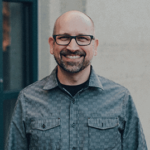We’re continuing the conversation about the church’s #1 priority: making disciples. We’re trying to answer the questions:
What does spiritual progress look like? And, how can we help people recognize movement in their own journey?
Last week we discussed 6 Indicators of Spiritual Growth. But if we’re going to build a framework that helps move people toward maturity and Christ-likeness, we’ve got to think clearly about identifying steps where progress can be measured. Many churches these days are referring to this idea as a “Discipleship Pathway,” a simple map that helps people know what their next step or season will look like.
We can learn from IKEA, a store that does a great job moving people through a simple, purposeful pathway.
My first experience at IKEA was magical. The giant, waving flags outside the massive, blue structure with yellow, giraffe-sized lettering made me feel like I was walking into a theme park. We entered through the front door and I instantly felt drawn in. It wasn’t just because of my Scandinavian heritage either — it was actually the numbers on the wall above the escalator that got me. “1, 2, 3, 4.” All the steps were laid out larger than life. It was shopping for dummies, and when it comes to shopping, that’s exactly what I need.
At IKEA, I don’t need to know about color schemes or how to pair furniture. That’s already been thought through for me. I don’t even need to know where stuff is. I just need to be able to follow the arrows, recognize what I like and write down numbers. Waiting at the other end of my hard work is…a delicious dish of Swedish Meatballs. I’m telling you, these people have it figured out.
Maybe the reason people are confused in church is because we expect them to know what’s going on without any explanation.
Here’s the point: IKEA works because they’ve done the work ahead of time. They’ve pre-designed the shopping experience from start to finish, and even thrown in some pleasant surprises. Understandably, it doesn’t suit everyone, but you’ve got to admit it’s a lot better than walking into a warehouse with a giant pile of “assemble-it-yourself” furniture in the middle. I for one would be lost.
Can you imagine what would happen in the church if it were to be as intentional as IKEA about moving people through a purposeful pathway?
First off, we would need to have one. And secondly, it would need to work. But if those things were true, we could turn the world upside down in a single generation.
With that in mind, here are 5 questions to ask for a better discipleship process:
1) Does it help people start?
The law of familiarity means that we forget what it was like to be new. Like me, walking up to a large building to shop, which I normally would avoid at all costs, most people need a low threshold if they’re going to enter a new way of life.
Where did “discipleship” start for Jesus? The answer, of course, is at the very beginning. His first words to many of his followers were “follow me.” And that was the moment he started discipling them. No background check. No survey. No prerequisites. Just people on a path. Maybe the reason people are confused in church is because we expect them to know what’s going on without any explanation. Perhaps if we designed the discipleship on-ramps at our churches for those with little or no church experience, it would work.
Baby Step: Require every serving environment in your church to have entry-level positions, where anyone can serve no matter their spiritual stage, background or church experience.
Fringe Benefit: If the word gets out that this is how your church functions, your first-time guest rate will start to climb significantly.
2) Does it help people stick?
Have you ever quit a job because you discovered you couldn’t go anywhere in the company? Upward mobility is important in our work lives, and it’s also important in our spiritual development. Not only do we need a low threshold, we also need a high ceiling. The mark of a good discipleship pathway is that everyone always has a compelling next step to take.
What is the goal of discipleship? Where should our pathway lead? Even a quick glance at the New Testament reveals that multiplication is the goal. Making disciples who make disciples. Unlike a dead-end job, that is not a boring proposition. I’m firmly convinced it’s the most exciting and important work on planet earth. And we are accountable to ensure it happens in our generation.
Baby Step: Insist that every key leader in your church find an apprentice over the next 6 months to 1 year. More than any curriculum you could design, this will force the types of conversation and development that lead to transformation.
Fringe Benefit: People will stay engaged longer in your church. That means you’ll end up with stronger leaders, more volunteers, and a better support base. Who wouldn’t want that?
3) Is it visible?
My wife and I once rented a scooter in Rome. It was a thrilling experience, but we didn’t make any progress. Our problem was that we had a hard time seeing the street signs because they’re chiseled into the sides of the buildings and we didn’t realize it. We got lost so many times we lost count. Ideally we would have known where we were starting, where we wanted to go, and how to get there. Road Trip Basics, right?
If God were to send 100 new believers to your church this weekend, how would they discover their next steps?
Baby Step: Print a 1-page handout designed for new people that tells them how your church can help them grow spiritually. What do you already have in place? What new resource, class, group or idea do you need to create? Be sure the threshold is low and the ceiling is high. Put it in a prominent and accessible place. And make plenty of copies.
Fringe Benefit: Your team will start thinking systematically about how to help people move spiritually.
4) Is it simple?
IKEA works because even a novice like me can remember the steps and easily succeed. As Andy Stanley says, they’re easy and they’re obvious. I would add, they should be few and memorable. Research indicates that a process with more than 4 steps is too complex to be effective in the long run with a large volume of people. So as we design our pathway, it’s got to be simple.
What’s the simplest approach that could possibly work?
Baby Step: Read “Move” by the Willow Creek Association, along with your leadership team. Then sketch out version 1.0 of your new discipleship pathway. Don’t worry about making it perfect. Just start. If you do this right, things will change and evolve along the way.
Fringe Benefit: The people in your church will start taking initiative on their own. The bottom line is that most people want to do the best thing if they know what that is.
5) Is it relational?
Nobody wants to be a cog in our wheels or a number in our systems. Our discipleship pathway has to be more than another part-time job for people, with endless tasks and lists. It has to be relational. As you consider how you’ll help people grow, keep in mind that culture eats strategy for breakfast, and environments do more to shape character than programs.
How could you get people around other catalytic Jesus-followers in your church more often?
Baby Step: Make a list of the Top 10 spiritual influencers in your church and invite them to have a meal with you to pick their brains on how they approach discipleship. Share your goal of creating a simple, compelling discipleship pathway and ask them to pray and help.
Fringe Benefit: People support what they help create. By inviting the influencers into this discussion, they’ll be more likely to embrace a renewed vision for discipleship and your team’s capacity will expand.
We would love to hear about your experience. What has been helpful for moving people along the path of discipleship in your context?








Leave a Reply